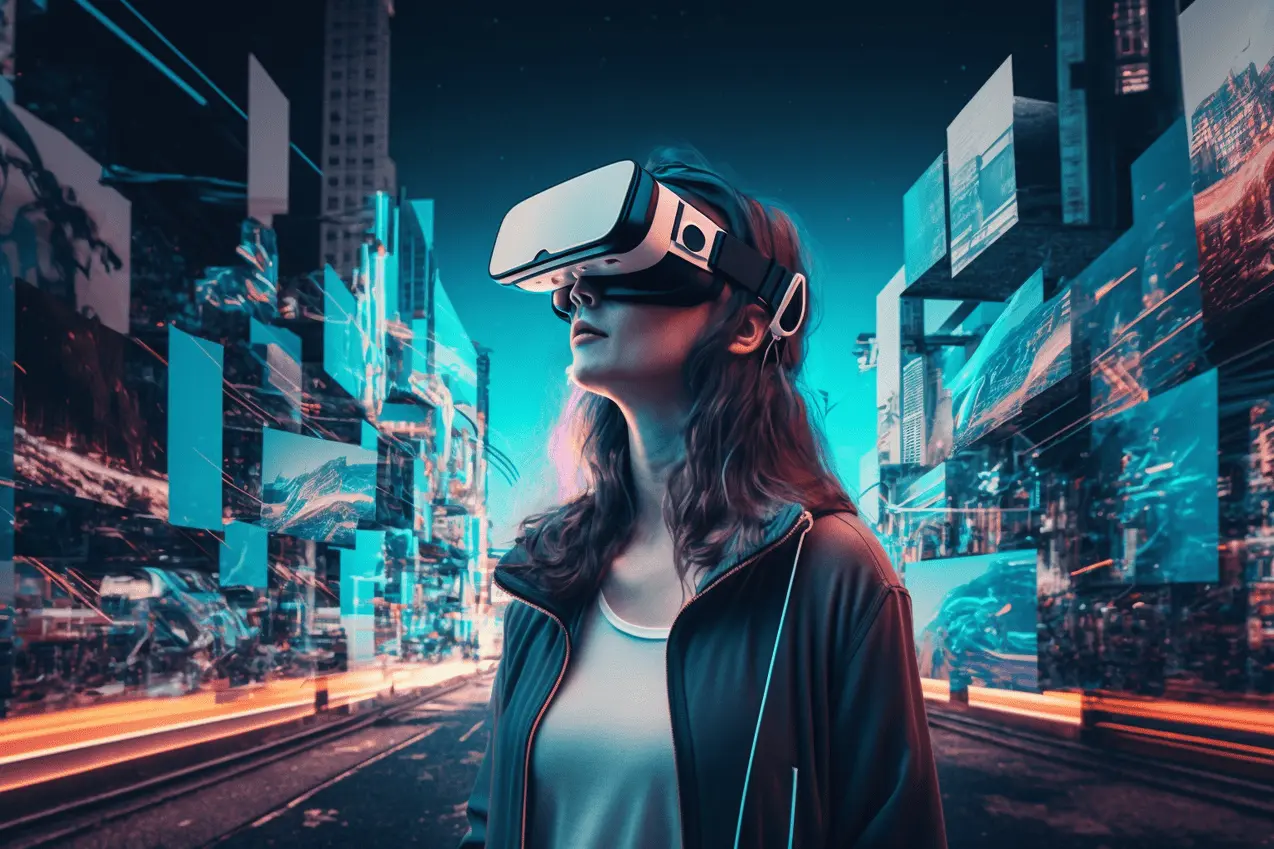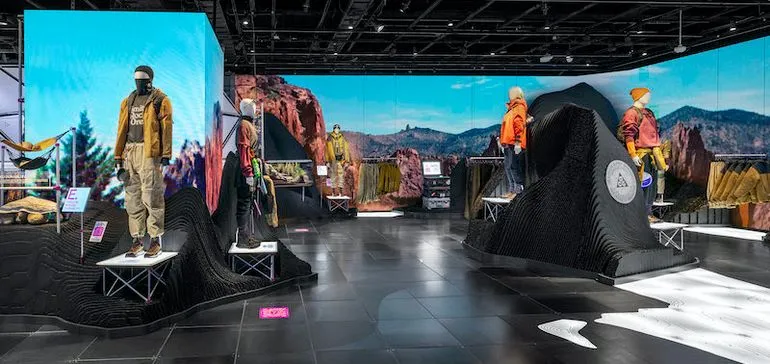
The metaverse, revolutionizing digital experiences, presents vast marketing opportunities for brands, highlighted by a significant uptake in 2021 due to AR and VR advancements. Leading companies, from Prada to McDonald’s, have leveraged the virtual space, employing strategies from developing metaverse games to NFT incorporation and partnerships with influencers.

With the metaverse market expected to soar to $1,303.4 billion by 2030, innovative and adaptable marketing approaches are essential for brands aiming to thrive. This article offers a guide on successful metaverse marketing tactics, urging brands to stay current with technology and consumer trends to capitalize on this growing platform.
So, let's get started and explore how you can use the metaverse to take your brand to new heights!
Top 7 Metaverse Marketing Strategies ⬇️
1. Brand-Sponsored Game Modes
AMD x Fortnite
Industry: Computer hardware, e-sports
AMD partnered with MAKAMAKES to introduce four new maps in Fortnite Creative Island, ingeniously designed to resemble an AMD RX 6000 graphics card and an AMD Ryzen 5000 processor. These immersive islands offered players diverse gaming modes, including free-for-all battles, box fights, and capture the flag, enhancing the gaming experience. Further amplifying their marketing strategy, AMD collaborated with MAINGEAR to give away a gaming PC powered by an AMD Ryzen 7 processor and Radeon RX 5700 XT graphics card, showcasing AMD's innovative approach to engaging with the gaming community and marketing their products.
Reason for AMD’s Success:
AMD's successful campaign can be attributed to two main factors. Firstly, it chose the perfect metaverse, Fortnite, as it required high computer specifications, which AMD is known for. Secondly, AMD effectively integrated its brand into the game by incorporating AMD hardware onto the creative map, which made the overall experience seem seamless and integrated.
2. Augmented Reality Store
Nike x Hovercraft
Industry: Fashion, footwear

Nike has expanded the metaverse concept beyond VR by incorporating AR within its New York House of Innovation. Through a partnership with Hovercraft, Nike launched its ACG HO20 collection in a digitally interactive environment. Customers could scan QR codes at various stations to explore an AR basecamp map, view animated local wildlife, and interact with a digital AR model of the Nike ACG Hiker mascot, providing an immersive outdoor experience within the store's confines.
Reason for Nike’s Success:
Nike leveraged COVID-19 pandemic to its consumers the capabilities of the metaverse. The pandemic brought consecutive lockdowns, making it hard for people to explore the outdoors. Nike made use of this fact and gave its customers an unforgettable wildlife journey through the help of AR. This campaign shows priority for customer experience, as well as brand innovation.
3. Virtual Events and Concerts
Ariana Grande x Fortnite
Industry: Music, entertainment
During the pandemic, Ariana Grande and Fortnite demonstrated the metaverse's potential by hosting a virtual concert, the Rift Tour, within the game. This collaboration offered players an unparalleled musical journey, featuring live performances of Grande's hits including "Raindrops," "7 Rings," and "Positions." The event showcased Ariana's avatar with dynamic choreography and costume changes, providing a vibrant and immersive experience. This innovative approach highlighted how virtual worlds can bridge the gap caused by real-world restrictions on live events.
Reason for Ariana’s Success:
Virtual events and concerts are the perfect way to captivate an audience in the metaverse. Ariana Grande didn't just entertain seasoned metaverse players, but also introduced new fans to the virtual world. Ariana’s show was the perfect example of bringing the best of both worlds together–an unforgettable musical experience inside a virtual game.
4. Virtual Wearables
Gucci x Zepeto
Industry: Luxury, fashion

Gucci and Zepeto's partnership allows fashion enthusiasts to dress their avatars in Gucci's latest collections, reflecting their real-life style in the game's virtual world. This collaboration includes access to a Gucci-themed virtual space, showcasing the fashion brand's foray into the metaverse alongside similar moves by Balenciaga with Fortnite, introducing new outfits for characters.

Beyond fashion, Coca-Cola ventured into virtual wearables with NFTs for Decentraland, highlighting a trend where both fashion and non-fashion brands are embracing digital attire to enhance avatar self-expression.
Reason for Gucci’s Success
Online identities are as crucial in the metaverse as our actual identities in real life. Avatars in the metaverse represent the players’ taste, identity, and personality. Brands like Gucci, Balenciaga, and Coca-Cola are giving these players the opportunity to express themselves the way they would off-screen. These brands might even be giving these players a chance to wear virtually what they can’t in actuality. Launching virtual wearables is one of the most-effective, interactive ways to engage the metaverse market.
5. Metaverse Location
Millennium Hotels x Decentraland
Industry: Accommodation, hospitality

Millennium Hotels and MullenLowe Singapore have introduced M Social Decentraland in Decentraland, marking the first entry of a hospitality group into the metaverse. This virtual hotel offers players a unique experience where their avatars can unwind and explore luxury amenities. An avatar host greets guests in the lobby, guiding them through the hotel. Additionally, players can win real-world hotel rewards by reaching the top of the virtual hotel and sharing their achievement on social media with the hashtag #MSocialDecentraland.
Reason for Millenium Hotels’ Success:
Millennium Hotels is all about setting trends and forging connections with their guests, and their latest marketing strategy proves just that. M Social Decentraland is the first hotel of its kind to offer virtual guests a chance to experience the luxurious perks and amenities of a real-life hotel, blurring the lines between the real and virtual worlds.
6. Virtual Influencers
Samsung x Shudu & Miquela
Industry: Consumer electronics
When it comes to the metaverse, tech brands know that virtual influencers are key to showcasing advanced tech and creating a digital representation of their brand. And Samsung is no stranger to this strategy, being one of the first brands to leverage virtual influencers to promote their latest products.
For its social media marketing campaigns, Samsung partnered with virtual influencers Shudu and Miquela to promote the new Samsung Galaxy Z Flip and the Samsung Galaxy Series. The Galaxy Z Flip is one of the first touch screen flip phones available today, which made Samsung’s collaboration even more sensible, with Shudu being the world’s first digital supermodel.
Reason for Samsung’s Success:
Samsung was able to tap onto the full potential of the metaverse and influencer marketing when it chose virtual influencers as brand ambassadors. Social media platforms are flooded with thousands of influencers, and a brand can only make an impact if it chooses the right one. Samsung, by choosing Miquela and Shudu, showed innovation and authenticity in the digital world.
7. Virtual Billboards
Boohoo x Paris World in Roblox
Industry: Fashion, clothing
Billboard advertising, effective in both the real and digital worlds, has proven its value in the metaverse, particularly during live events and in areas with high avatar traffic. Boohoo capitalized on this strategy by featuring its brand on two prominent billboards at the entrance of Paris Hilton’s virtual fashion week on Roblox, ensuring visibility to all attendees. This technique underscores the belief, shared by Paris Hilton, that the omnipresence of billboards in our daily lives should extend seamlessly into the metaverse.
Reason for Boohoo’s Success:
Boohoo brought a familiar element to the unfamiliar. The metaverse is a relatively new world which not a lot of people have already fully grasped. Boohoo, by putting up billboards during the event, offered a sense of comfort and normality to the players, and also made the metaverse closer to real life.
Conclusion
The metaverse opened up new marketing strategies for brands to try and hop on. Brands which are launching marketing campaigns in this virtual world are looking at a bright future–they are able to secure their spots into the new generation of tech and consumerism.
We hope this article has helped your brand discover and understand the best ways to do marketing in the metaverse. We hope the cases we’ve provided serve as inspiration for your next campaign.
Contact Us
AJ Marketing | Unlock the Power of Influence



